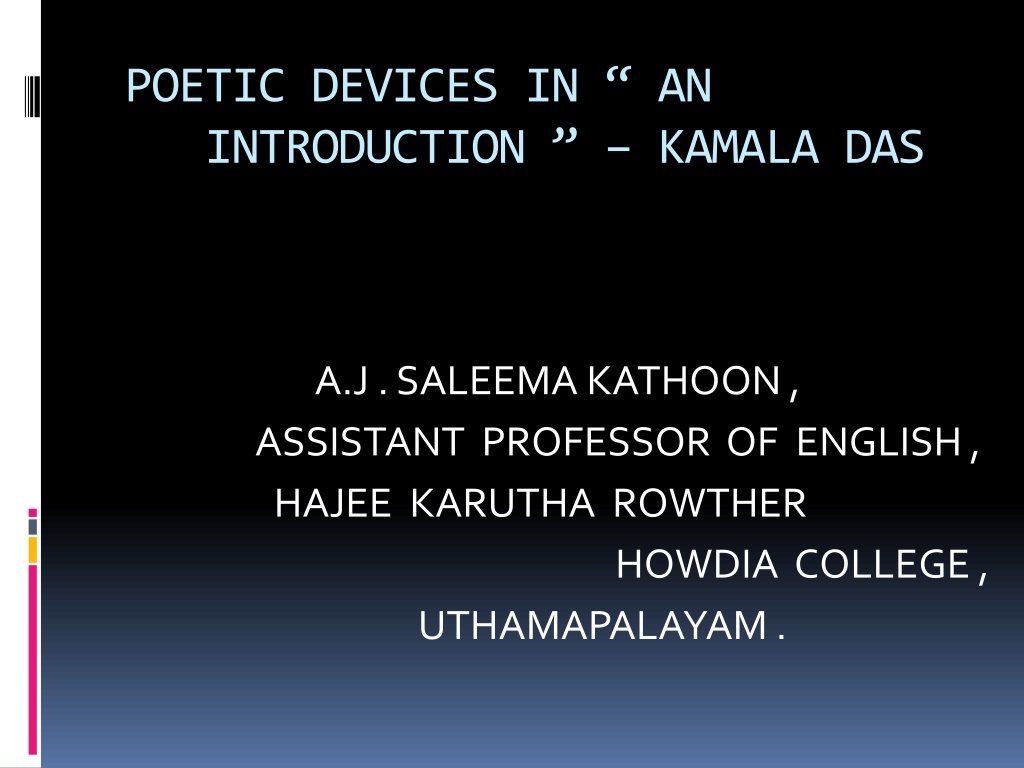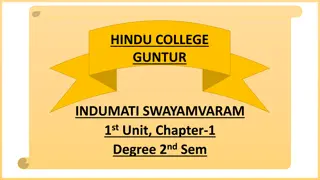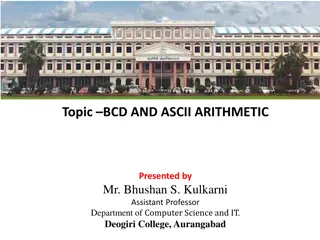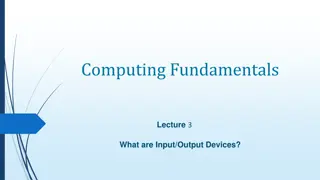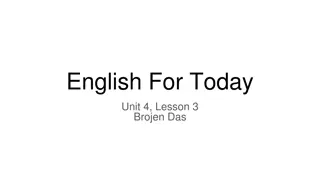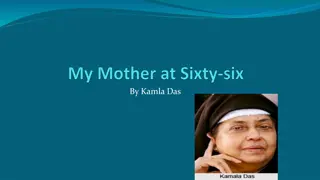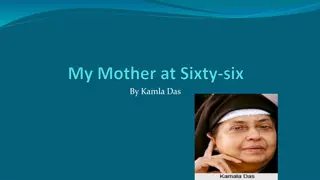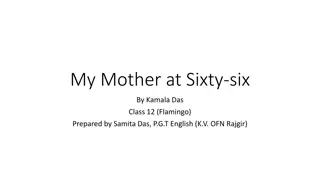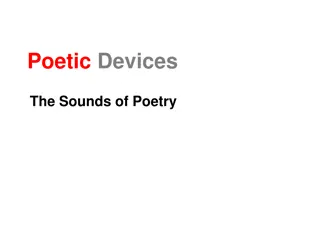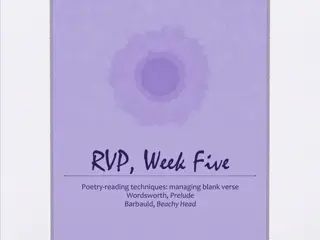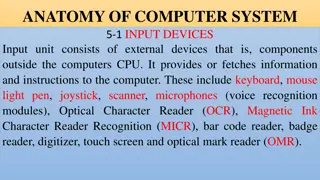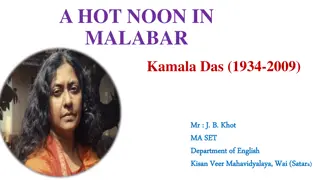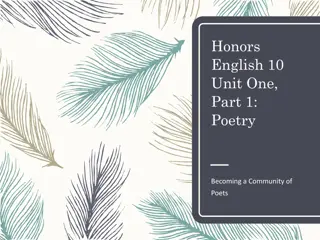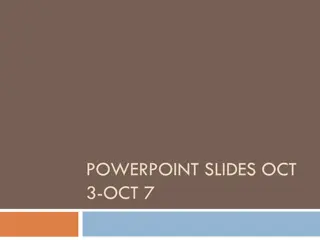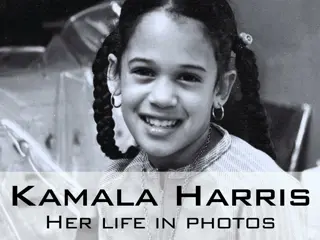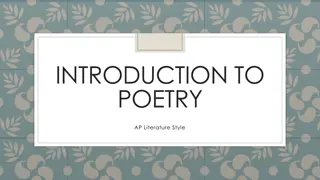Kamala Das: Poetic Devices, Life, and Works
Kamala Das, also known as Kamala Surayya, was a significant voice in Indian literature with a focus on powerful and truthful poetry. Embracing Islam later in life, she wrote passionately about feminism, freedom, and marriage. Her notable works include "Summer in Calcutta" and "My Story," reflecting her confessional and autobiographical themes. This introduction delves into her life, literary contributions, and exploration of feminist ideals.
Download Presentation

Please find below an Image/Link to download the presentation.
The content on the website is provided AS IS for your information and personal use only. It may not be sold, licensed, or shared on other websites without obtaining consent from the author. Download presentation by click this link. If you encounter any issues during the download, it is possible that the publisher has removed the file from their server.
E N D
Presentation Transcript
POETIC DEVICES IN AN INTRODUCTION KAMALA DAS A.J . SALEEMA KATHOON , ASSISTANT PROFESSOR OF ENGLISH , HAJEE KARUTHA ROWTHER HOWDIA COLLEGE , UTHAMAPALAYAM .
About The Poet : Kamala Surayya (31 March 1934 31 May 2009) was formerly known as Kamala Das. She was also known by her name Madhavikutty. Kamala Das is the Mother of Modern English Indian Poetry. And she was one of the significant voices in Indian bilingual writers, at the same time a leading Malayalam author from Kerala, India. Kamala Das embraced Islam at 65 later she received the name Kamala Surayya.
CONTINUES.... Kamala was born in Punnayurkulam, Malabar District in British India (present-day Thrissur district, Kerala, India) on 31 stMarch 1934, to V. M. Nair, a managing editor of the widely circulated Malayalam daily Mathrubhumi, and Nalapat Balamani Amma, a renowned Malayali poet.
Kamalas Literary Works : Kamala s poetry is noted for its powerful passion, a confessional strain and autobiographical themes. Most of her poems are remarkable for their power and raw truth. A bilingual writer, her works in English and Malayalam include Summer in Calcutta (1965), The Descendants (1967), The old Playhouse and Other Poems (1973), My Story (1974), an autobiography.
Continues... A few of her stories, originally in Malayalam language, published in Modern Indian Short Stories : An anthology (1974). She was given the poetry Award of the Asian PEN Anthology in 1964 and the Kerala SahithyaAcademy Award in 1969 for Cold , a collection of short stories in Malayalam. Her poems have appeared in Opinion, New Writing in India (Penguin Books, 1974) and Young Commonwealth Poets 65.
Themes in An Introduction Das explores powerful themes of feminism/equal rights, freedom, and marriage in An Introduction . This poem is a very clear feminist statement that advocates for free choice for all women. This is in regards to every aspect of life, but the poet puts a special emphasis on marriage. She compares and contrasts the roles of men and women in society and explains for the reader how her life, the rules she s forced to obey, infringe on her freedom.
Structure and Form of An Introduction : An Inroduction is a sixty line poem that is contained within a single stanza. The lines range from three words up to eleven and do not follow a specific metrical pattern. Das also chose not to use a rhyme scheme. The lines also vary greatly in length and syllable number.This means that the poem is written in free verse. This style of writing allows the poet to explore various structures and make use of more sporadic rhymes. There are several examples of half- rhyme and internal rhyme in An Introduction .
Literary Devices in An Introduction Kamala Das uses techniques such as enjambment , repetition, and anaphora. Repetition and anaphora are seen at the beginning of a number of lines, such as four and five. In this instance, the speaker is giving two conviction filled statements about who she is. This is conveyed through the repetition of the pronoun I . Later on, repetition is used again to define her language as both English and human . She is a human being, as equal and valuable as any other.
Continues... There are also several examples of allusion. She references a specific place and the name of a politician that requires some research in order to understand. Enjambment is another important technique. It can be seen throughout this poem, but one good example is the transition between lines fifty- eight and fifty-nine.
Summary in short.. An Introduction by Kamala Das describes the poet s own mental and emotional state as she aged and pushed back against patriarchal society. An Introduction begins with the speaker, Das, stating that she knows all the male leaders of India. Their names are a part of her, a tribute to their overwhelming power.
Summary continues.. This contrasts significantly with the lack of power she felt growing up and getting married at sixteen. She struggles with her identity and is finally able to step away from the traditional role of wife. Das describes the way that men are able to move through the world with a solid identity.
Continues... They are allowed their choices and emotions. In the last lines, she pushes back against this way of life by stating that she feels things that do not belong to the man she loves. She too can be I.
